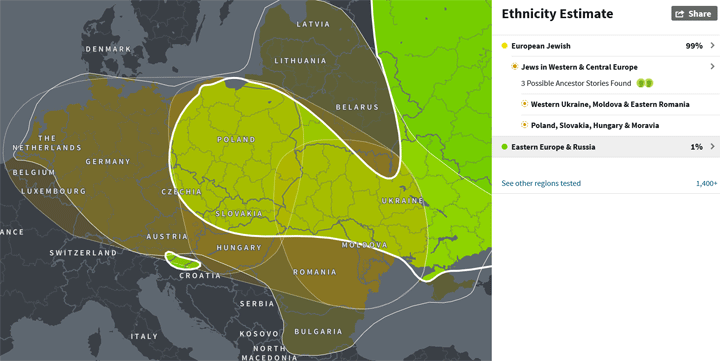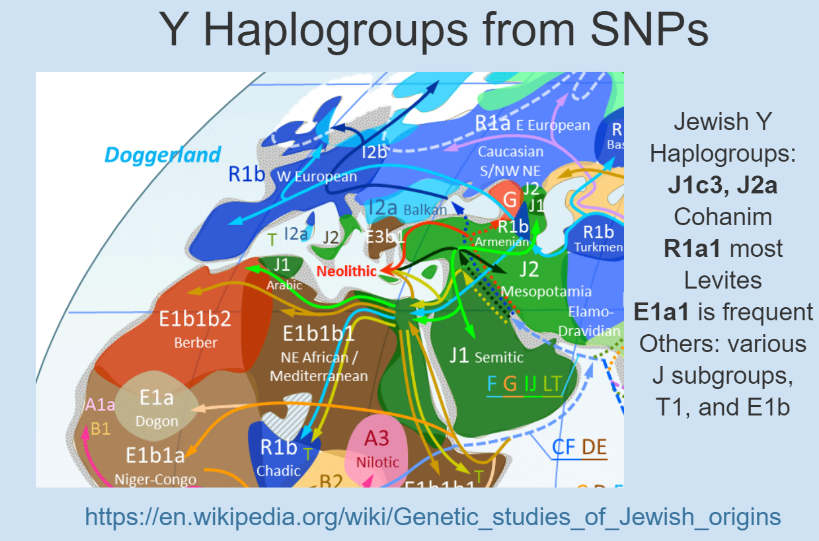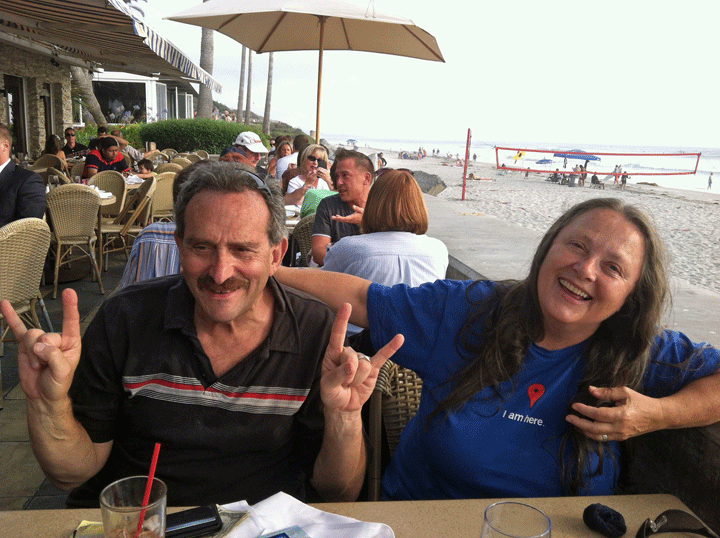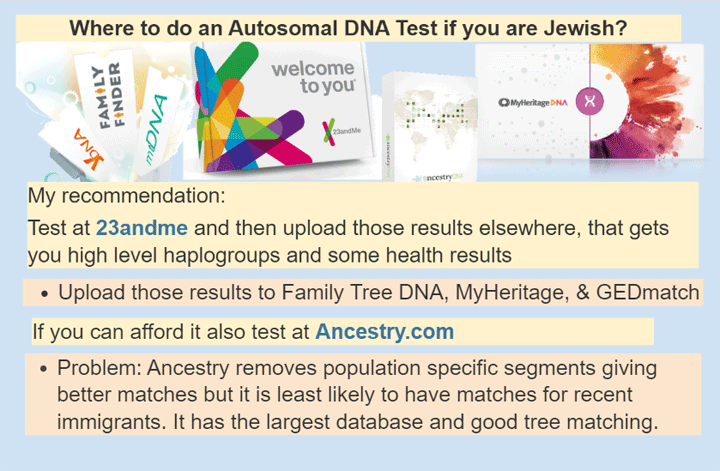It is time to update my recommendations on dealing with Ashkenazi Jewish DNA, the DNA of those who are Jewish of Northern European origin, often abbreviated AJ. The usual goals of DNA testing are to find out where your ancestors were from, to find cousins who might have good family stories, to confirm your paper genealogy, and perhaps to check on health issues. There are some special considerations for AJ DNA.
First, for Ashkenzi Jews, the ethnicity results are usually not very useful as they look like this:

Typical Ashkenazi Jewish DNA Origins as shown at Ancestry.com
Of course for some with a larger than 2% non-Jewish percentage, it can confirm a non-Jewish ancestor.
Another deep ancestry goal for the Jewish male is to confirm or look for Cohanim or Levite roots. If your Y haplogroup belongs to one of those (see below) then best to do full Y testing over at Family Tree DNA which has projects for Levites and various Cohen groups. 23andme gives you your high level haplogroup but the other testing companies do not. If you tested elsewhere, click here and scroll end of this article to learn how to get your Y haplogroup: Why Y?.

Slide on Jewish Y Haplogroups – image from a Y haplogroup crative commons image at wikipedia, no longer available
Finding relatives is difficult because all of us Ashkenazim are related multiple times, both way back when and more recently. Most AJs look like 4th or 5th cousins to each other even when that is not the case. Cousin marriages, uncle-niece marriages, and other close family marriages abound in our trees. In my own family, on my Jewish line, my great grandmother fixed up her sister with her husband’s brother to get that dowry for the family business so I have double third cousins. Click here for my article from back in 2014 that suggested that we are all descended from 350 people in the 1300s.
This means the Shared Matches feature at Ancestry is useless to us because it does not show how the two matches are related to each other and that can be quite distant [UPDATE: 26-Apr-2025: With Ancestry’s new pro tools you can see how your matches are related to each other]. Both MyHeritage and 23andme are kind enough to show how the shared matches are related to each other.
In my experience, actual close relatives will always share large chunks of DNA. Therefore I have come up with the following guidelines for finding real 3rd and 4th cousins on your Jewish lines: those DNA matches with at least one segment > 20 cM and another > 10 cM among 5 or more segments.
Last Wednesday I was scheduled to give a lecture on Jewish DNA for the Jewish SIG of the Dallas Genealogical Society but I took my husband to the ER instead. Fortunately I had pre-recorded the talk. This blog post is intended to supplement that talk for them. Click here for those slides. They include my recommendations on where to test if you are Jewish. [UPDATE: Click here for the video of the talk Challenges of Endogamy: Jewish DNA testing UPDATE 26-Apr-2025: go to the 9 minute mark where my talk starts.]
Finally, checking your DNA for possible health issues can be very important, especially for an endogamous group like Ashkenazi Jews. My husband’s LILIEN family had so much breast cancer and melanoma that it was not a surprise to discover he has a bad BRCA2 gene. His mainstream DNA tests did not pick that up, but the Color Genomics test ordered by his oncologist found it. My sleuthing determined which family line and has perhaps saved a life by getting them tested (yes breast cancer caught early enough). Blogger Lara Diamond also has a BRCA2 deletion caught by 23andme in time for her. Click here for her story.
It is a difficult time here for me due to my husband’s failing health so I am not blogging very often. UPDATE 31-jan-2022: it has been 10 months since he passed away and I am still not blogging as often as I used to… I still do many talks though, some of which are online.

At my favorite restaurant, Poseidon, with my husband in better days. Click here for more about the sign of the horns which Steve is making, Your guess as to why …

Sorry to hear about Steve.. Hope to see you back at a bridge table eventually. Steve comes up as a remote cousin to me but I haven’t found any link.
Sherryl all Jewish people are related. Steve shares an 11 cM X segment with me and no common ancestors for 200 years or so.
Another problem with AJ that I should have mentioned is the lack of deep trees and the taking of traditional surnames only occurred in the early 1800s
I have no Ashkenazi so far as I know, but I do have a bucket of US matches that go way back to early colonial times – around Mayflower and just after.
They appear really close by DNA (often 3C or 4C) but their trees say that any CA must be one or two generations before the Mayflower.
My recollection is that your guideline for true Ashkenazi close matches should work well for these also. I will investigate further. Thank you.
Pity for me that so many of them test nowhere else than the place without a chromosome browser. (And for them in their efforts to jump the pond.)
Yes early colonials were also endogamous so the AJ guidelines may help there as well.
Thanks for the update, and sorry to hear about Steve.
I have been following a similar strategy to your recommendations for AJ autosomal testing, although taking multiple people into account. For instance, I tested two siblings, one with 23andMe and the other with Ancestry, and then uploaded to other sites. The last time I tried uploading into FamilyTreeDNA I didn’t have any luck… if it’s working for you, perhaps it’s time for me to try it again.
At family tree DNA sort by largest segment. There are many Jewish people tested there so yes it is worthwhile. Try GEDmatch also.
Iam 49 % to 50% Askanazi Jewish.
I have hundreds of 3rd 4 or5 times removed. I wrote to some a few replied but not interested in Family History
I do not understad it very well but am learning slowly.
Anne –
You wll get a better response rate if you offer them information. Learn as much as you can about your families and where they were from. Those 3rd or 4ths may not really be so if there are no large segments so I suggest only contacting the ones with large segments.
Also read this older post of mine and look at Gaye Tannenbaum’s tips: https://blog.kittycooper.com/2014/11/using-ashkenazi-jewish-dna-to-find-family
Sorry, I meant I didn’t have any luck with the upload, FamilyTreeDNA was not able to load the file. I will try again when I have some time.
I’ve recently expanded from close family to asking cousins… virtually none have taken up my offer but the one that did has really helped in identifying and interpreting matches.
DNA matches with at least one segment > 20 cM and another > 10 cM among 5 or more segments. Hello Kitty, could you please explain the 2nd part of this sentence., the 10 cM among 5 or more segments. I find this very confusing.
Thank you.
A total of 5 or more segments of which at least one is > 20 cM and another > 10 cM
Hi Kitty,
Wishing the best for Steve and you.
Do you think Y DNA is a better way to focus on AJ, since it would minimize the typical problem of endogamy and inflated cM totals from autosomal DNA?
Paul Baltzer
Paul –
Y is rarely useful for AJ other than deep roots. Since surnames were only taken for most in about 1815, the results do not usually show any one last name. See this slide: https://slides.com/kittycooper/challenges-of-endogamy-jewish-dna-testing#/8 from my recent talk.
So use autosomal but only investigate those matches with large segments.
0.1 % AJ, and proud of it (23andme). So minor, it could be an error I suppose (kind of new to this). Going to start pulling that thread. Peace/Shalom.
well Steve, AJ DNA is very distictive but that little could still be noise. SInce you are at 23andme, you can get the exact segment(s) that are AJ – see https://blog.kittycooper.com/2016/12/ancestry-composition-numbers-by-segment-at-23andme-com/ …. and then perhaps use GEDmatch to search for matches on that segment.